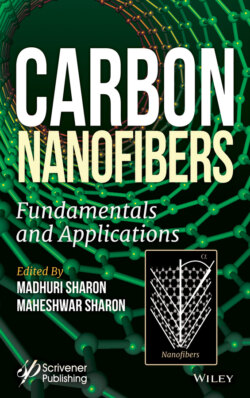Читать книгу Carbon Nanofibers - Группа авторов - Страница 77
3.3.4 Reverse Micelle Method of Metal Nanoparticles
ОглавлениеReverse micelles are formed when surfactant molecules possessing polar head group and hydrophobic tail are placed in nonpolar solvent. In reverse micelle structure, surfactant molecules aggregate into nano-sized spherical structures having core of polar head groups and shell of hydrophobic tails. If a small amount of polar solvent is present in the mixture, it would be enclosed in a core of reverse micelles. If this polar solvent contains an oxide precursor, then controlled hydrolysis of precursor will be achieved by mixing a small amount of water and small particles of metal oxide will form at core. For example, nano Al2O3 is prepared by this method.
A solution of inverse micelles is first formed by adding a long-chain alkylamine to a toluene solution. A small amount of water is trapped in the reverse micelle core. Mixing the reverse micelle solution with an aluminum alkoxy amine adducts results in hydrolysis of the aluminum alkoxide adduct and formation of nano-sized particles of aluminum hydroxide after drying (Figure 3.3).
Reverse micelle synthesis method is also reported for preparation of supported metal catalysts. Cheney et al. (2011) reported synthesis of alumina- supported Pt/Ni bimetallic catalysts by reverse micelle synthesis method [11]. In this method, two microemulsions were created by mixing 15% water, 10% surfactant and 75% hydrocarbon (cyclohexane and propanol). Ni and Pt precursors were added to microemulsion-1 and hydrazine to the microemulsion-2.
Figure 3.3 Schematics showing formation of nano-sized particles of aluminum hydroxide by reverse micelle method. (Source https://edurev.in/studytube/Nano-metal-or-metal-oxide-catalysts--Catalyst-Scie/9b6f7900-95f8-4c67-a444-ef2f86a4b1fd_t#) [56].
Each mixture was stirred separately for 1 h to allow micelles to equilibrate. In microemulsion-1, reverse micelles were formed having aqueous core and the Pt and Ni precursors were dissolved in aqueous polar core of the reverse micelles. Thereafter, the microemulsion-2 containing the reducing agent was added to the microemulsion-1 for in-situ chemical reduction of the metals at reverse micelle core. The alumina support was added to the solution and titrated with acetone to disrupt the micelles and precipitate the nanoparticles onto the support. The supernatant was decanted and the catalyst powder was rinsed with acetone. Residual surfactant was removed by giving heat treatment in oxygen environment.
